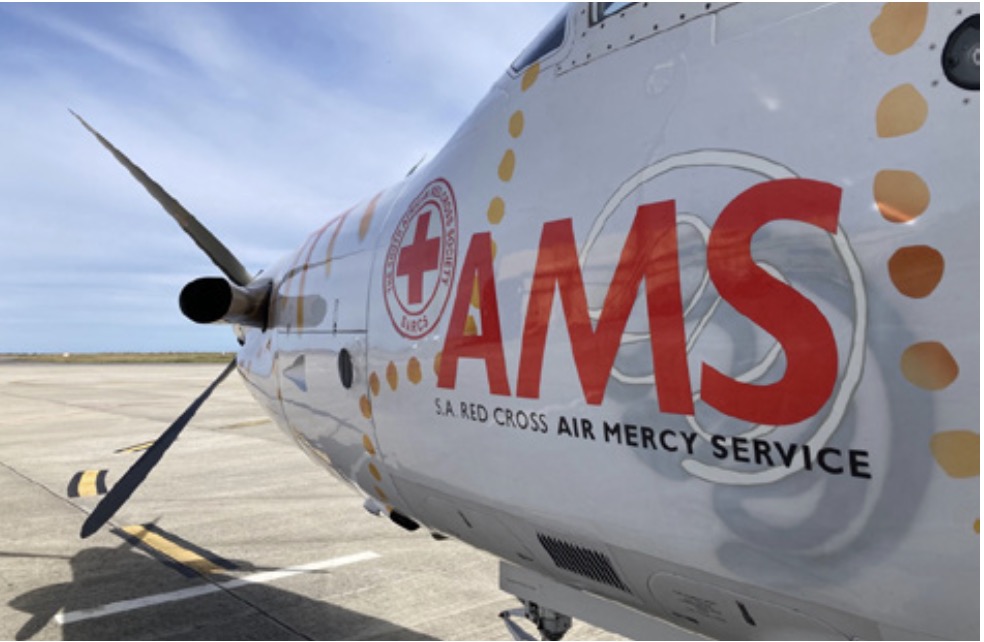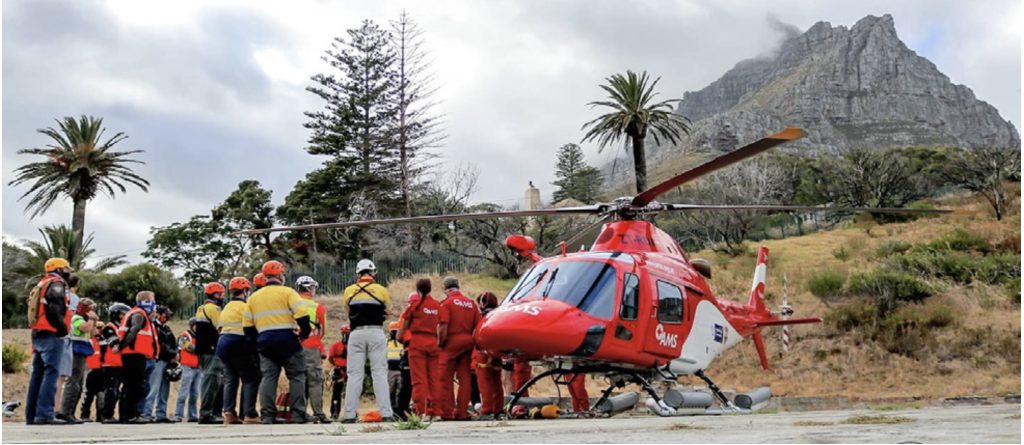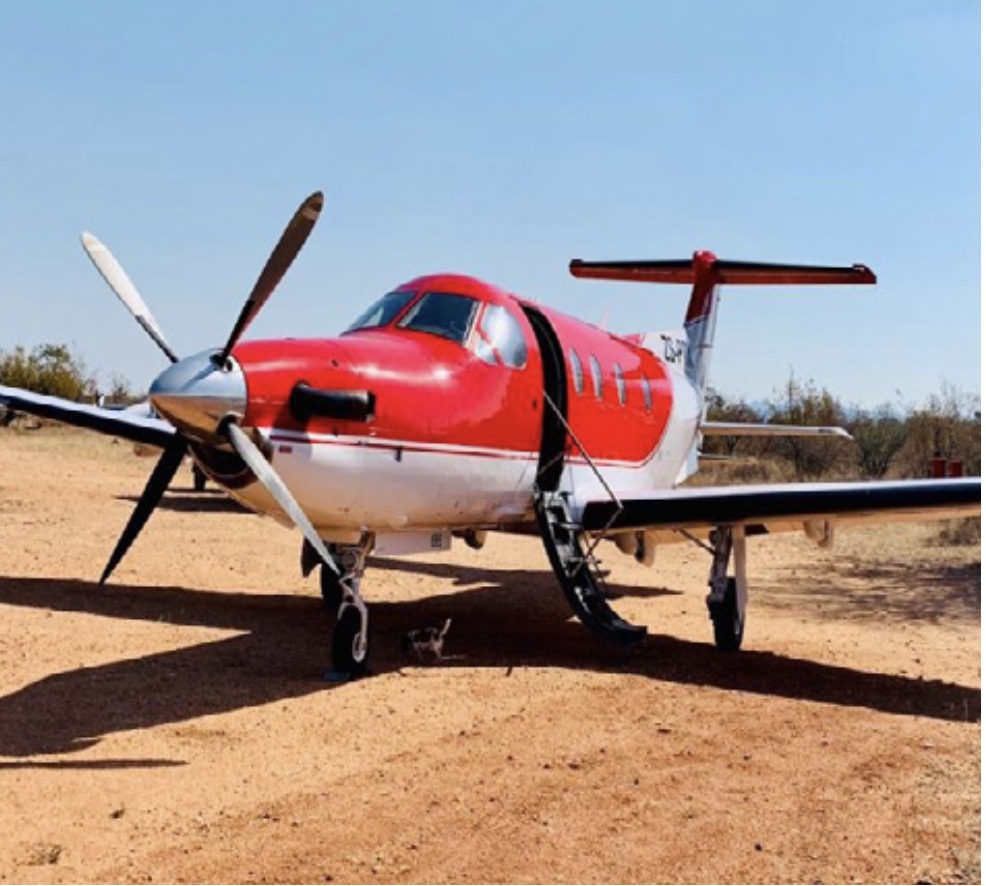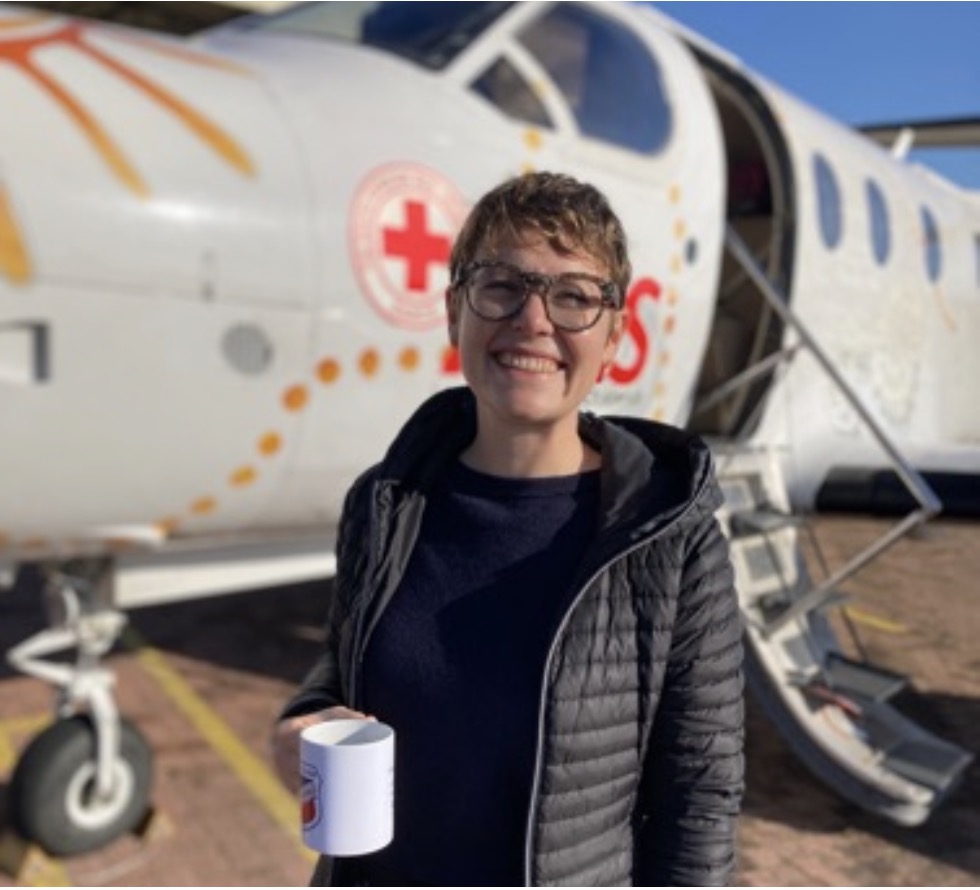THE AIR MERCY SERVICE OF THE SOUTH AFRICAN RED CROSS THE FLYING DOCTORS AND NURSES OF SOUTHERN AFRICA
Introduction
How it all began
The history of air ambulances dates back to the early 20th century, when airplanes and helicopters were first utilised during World War I, and the French and British military experimented with aircraft to transport wounded soldiers.
After World War II, air ambulances were increasingly adopted for civilians – particularly in remote and rural communities (1).
It was in 1966, that the first air ambulance flew in South Africa, when a civilian patient was transported with a small single engine Cessna 205 aircraft from Oudtshoorn to Cape Town, a distance of 420 km by road (2).
As South Africa is a vast country, it was evident that aviation could potentially provide essential medical help in remote areas, particularly after disasters. In response to this need, the Air Mercy Service (AMS) of the South African Red Cross was initiated and developed as an aeromedical organisation within the South African Red Cross Society (SARCS). This collaboration has enabled AMS to update and expand their fleet and medical services. Since then, AMS has become a beacon of hope, as a non-profit organisation providing medical care and transportation from poorly accessible areas across the entire country – as well as providing outreach and rescue services. The seven fundamental principles of the International Red Cross and Red Crescent Movement are to exhibit humanity, impartiality, neutrality, independence, voluntary service, unity and universality and these principles have been instrumental in shaping the ethos and operations of the work of AMS (2,3) Due to its rapid growth, the AMS was formed into an independent trust fund in 1994 and has since worked closely with the Departments of Health of the provinces of South Africa (4).
Since it began, AMS has helped people in hard-to-reach places by bringing them medical care and transport.
Healthcare Challenges in South Africa
South Africa faces a multitude of healthcare challenges. The most notable of these are the limited access to medical facilities and specialised medicine, as well as inadequate infrastructure, socioeconomic disparities, and the burden of communicable and non-communicable diseases.
In fact, South Africa has the world’s largest population of HIV-positive people – of about 7.1 million – and one of the highest incidences in the world of multi-drug resistant tuberculosis. Furthermore, there is a high burden of trauma that can be correlated with severe violence, road traffic injuries and substance abuse (5,6).

Figure 1: Pilatus PC12 fixed-wing aircraft of The South African Red Cross Air Mercy Service.
These challenges are exacerbated by the vast geographic landscape of the country. Even though health services are provided largely free of charge, the monetary and time costs of travel to a clinic continue to pose a significant barrier to access (7). Additionally, there is a very uneven distribution of tertiary hospitals as higher level care is limited to the major cities.
The healthcare system consists of a poorly funded public sector serving an overwhelmingly large portion of the population, with inadequate infrastructure, staffing and medication. Approximately 84 % of the population rely on the public system. The remaining 16 % have access to the private sector with significantly more resources (5).
South Africa’s healthcare shows stark inequality: 84 % rely on an underfunded public sector, while 16 % use a well-equipped private sector.
The South African Air Mercy Service
Due to the significant inequality gap within South Africa’s healthcare system, there has been an increasing need for medical assistance in remote and underserved areas. As an air-ambulance, AMS complements ground-transportation of critically ill or injured patients from rural areas. The AMS extended their fleet with helicopters in 2000, and could then also participate in primary responses and provide both air-sea and air-mountain rescue. Today AMS operates from the Western Cape (Cape Town and Oudtshoorn), KwaZulu-Natal (Durban), Eastern Cape (Mthatha, East London, Gqeberha) and from supportive infrastructure in the Northern Cape and Free State Provinces. It covers an area of 392,789 km2 and a population of about 25 million people – which is comparable to the population of Australia (8).
The AMS operates with fixed-wing as well as rotor-wing aircraft. The choice of aircraft varies upon distance, basic airport infrastructure on-site, and the patients’ clinic. The medical team consists of at least one paramedic for advanced life support (ALS) and one paramedic for Intermediate life support (ILS), both with wide practical experience.

Figure 2: Mountain Rescue Mission with Leonardo AgustaWestland Helicopter AW119.
Because of healthcare inequality in South Africa, AMS is crucial for reaching rural and remote areas, covering a population and territory similar to Australia’s.
The Fleet
The fleet consists of fixed-wing Pilatus PC-12 aircraft and rotor-wing Leonardo AgustaWestland AW119 helicopters. Both are specifically designed and equipped for intensive care transportation.
The Pilatus PC-12 aircraft, manufactured in Switzerland, is a single-engine aircraft with a nine-seater cabin with capacity for three patient stretchers. The PC-12 can reach a top speed of up to 450 km/h and is ideally dispatched for operations at a distance of more than 250 km. The aircraft thus allows efficient long-range medical evacuations and transfers. These aircraft require only a short takeoff and can land on small airstrips of up to 500 – 800 m. They are therefore suitable for operations in areas with very limited infrastructure (9,10).
The Leonardo AgustaWestland AW119 helicopter is a single-engine helicopter with an ideal operating radius of 200 kilometres and a maximum cruise speed of 250 km/h. It has full hoist, sling and winch capabilities, so that rescue missions are possible. As these aircraft can access inaccessible locations, they can assure a rapid response to emergencies on land and on water (9,1).
Flying Doctor Outreach Program
One notable initiative of AMS is the KwaZulu-Natal (KZN) outreach program. This initiative targets rural communities in the KwaZulu-Natal province. Through this program, AMS dispatches medical specialists, including many volunteers, to rural healthcare facilities. In local hospitals, they offer specialised treatments on site and even perform minor surgery and interventions (11). There is also a huge element of skills development and capacity building for all healthcare professionals at these rural facilities. Given that it could take up to two days by road to access tertiary care, this program not only reduces referrals to distant facilities, but also alleviates the lack of specialists and infrastructure in district hospitals (12).
AMS’s KwaZulu-Natal outreach program delivers specialized care to rural communities, reducing long hospital trips, and supports local healthcare training.
Facts and Statistics In 2022, AMS carried out a total of 1131 missions in the Western Cape from the bases in Cape Town and Oudtshoorn – including 687 rotor wing and 444 fixed wing missions.
During these missions, they provided medical care to a total of 1207 patients. For the entire year, a distance of 310,699 km was covered by fixed-wing aircraft, and 195,959 km by rotor wing, giving a combined airtime of 1685 hours (9).
The largest share of rotor-wing missions (47 %) was for general medical cases, followed by trauma at 20 % and neonatal care at 22 %. Nearly 30 % of all patients were transported in intubation. Interfacility transfers accounted for 75 % of all rotor-wing missions, whereas 20 % involved rescue missions. Of the rescue missions, 88 were performed on land and 14 at sea (9).
Challenges and Outlooks
The AMS service operates throughout the year. While flights are able to take off on most days, there may be restrictions due to adverse weather conditions, such as high winds, fog, and ice. Rural and remote communities often face infrastructural problems, such as missing air landing strips or unlit runway due to lack of maintenance, vandalism or the so-called “loadshedding”. Loadshedding results in hour-long power cuts in South Africa, which means that existing runway strips are unusable at night. Such restrictions severely limit missions in the dark, especially for fixed-wing aircrafts.

Figure 3: Pilatus PC 12 fix-wing aircraft
In any of those cases, AMS closely coordinates with ground transportation. Given the very limited number of ambulances serving in remote regions, this results in additional depletion of local resources (12).

Figure 4: MD Caroline Egger visiting AMS at Cape Town Base.
In the future, the AMS would like to expand their medical services. One area in which they are attempting to provide additional support is to start a new programme to address the shortage of surfactant for premature infants in rural areas. Emergency transportation of surfactant to the rural doctors is currently under discussion.
Despite weather and infrastructure challenges, AMS coordinates with ground transport to access remote areas and aims to resolve surfactant shortages for premature infants in rural communities.
Conclusion
The South African Air Mercy Service exemplifies the humanitarian ideals of the Red Cross/ Red Crescent Movement, by addressing healthcare challenges and bridging gaps in South Africa’s healthcare system. AMS continues to save lives, provide relief during emergencies, and empower communities with valuable healthcare services. As South Africa moves forward, the work of AMS remains crucial in ensuring equitable access to healthcare.
Acknowledgement
We would like to sincerely thank the Air Mercy Service for granting inside access into their remarkable work in emergency medicine in South Africa at the base in Cape Town, together with their generous support as well as for providing the photo material and statistics.
References
- Carter G, O’Brien DJ, Couch R. The evolution of air transport systems: a pictorial review. J Emerg Med. 1988;6:499–504.
- South African Red Cross Air Mercy Service. History. Available from: http://www.ams.org.za. Accessed: 30 June 2023.
- Hutchinson J. The history of the Red Cross is anything but dull. CMAJ. 1989;141:336–339.
- Exadaktylos AK, Smith W, Zellweger R, Erasmus P. The Red Cross Air Mercy Service: a developing air medical service in Southern Africa. Air Med J. 2004 Jan-Feb;23(1):34-5. doi: 10.1016/j.amj.2003.10.002.
- de Villiers K. Bridging the health inequality gap: an examination of South Africa’s social innovation in health landscape. Infect Dis Poverty. 2021 Mar 1;10(1):19. doi: 10.1186/s40249-021-00804-9.
- Coovadia H, Jewkes R, Barron P, Sanders D, McIntyre D. The health and health system of South Africa: historical roots of current public health challenges. Lancet. 2009 Sep 5;374(9692):817-34. doi: 10.1016/S0140-6736(09)60951-X. Epub 2009 Aug 24.
- McLaren ZM, Ardington C, Leibbrandt M. Distance decay and persistent health care disparities in South Africa. BMC Health Serv Res. 2014 Nov 4;14:541. doi: 10.1186/s12913-014-0541-1.
- South African Government. About SA. Available from: https://www.gov.za/about-sa/south-africa-glance. Accessed: 30 June 2023.
- South African Red Cross Air Mercy Service, Cape Town, South Africa. Personal communication. 3 November 2023.
- Thomas F, Wisham J, Clemmer TP, Orme JF Jr, Larsen KG. Outcome, transport times, and costs of patients evacuated by helicopter versus fixed-wing aircraft. West J Med. 1990 Jul;153(1):40-3.
- Caldwell RI, Gaede B, Aldous C. Description of an internal medicine outreach consultant appointment in Western KwaZulu-Natal, South Africa, 2007 to mid-2014. S Afr Med J. 2015 Apr 6;105(5):353-6. doi: 10.7196/samj.9173.
- D’Andrea PA, van Hoving DJ, Wood D, Smith WP. A 5-year analysis of the helicopter air mercy service in Richards Bay, South Africa. S Afr Med J. 2014 Feb;104(2):124-6. doi: 10.7196/samj.7310.
- Park-Ross JF, Howard I, Hodkinson P. Rescue Activity of a Civilian Helicopter Emergency Medical Service in the Western Cape, South Africa: A 5-Year Retrospective Review. Wilderness Environ Med. 2022 Dec;33(4):437-445.doi: 10.1016/j.wem.2022.08.001. Epub 2022 Oct 11.
- Howard IL, Welzel TB. Current practice of air medical services in interfacility transfers of paediatric patients in the Western Cape Province, South Africa. SAJCH. 2015;8:143–148.

Published under the Creative Commons Attribution 4.0 International License
